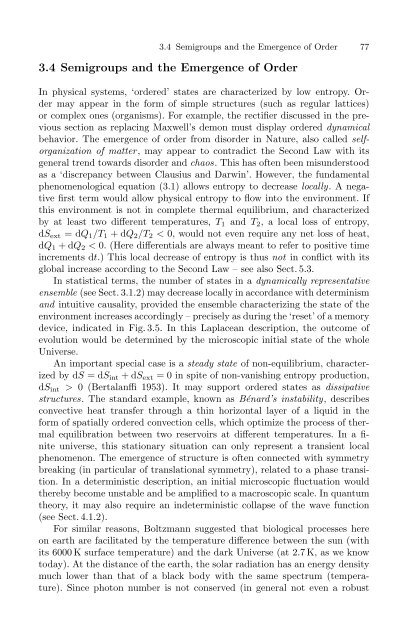The Physical Basis of The Direction of Time (The Frontiers ...
The Physical Basis of The Direction of Time (The Frontiers ...
The Physical Basis of The Direction of Time (The Frontiers ...
You also want an ePaper? Increase the reach of your titles
YUMPU automatically turns print PDFs into web optimized ePapers that Google loves.
3.4 Semigroups and the Emergence <strong>of</strong> Order 77<br />
3.4 Semigroups and the Emergence <strong>of</strong> Order<br />
In physical systems, ‘ordered’ states are characterized by low entropy. Order<br />
may appear in the form <strong>of</strong> simple structures (such as regular lattices)<br />
or complex ones (organisms). For example, the rectifier discussed in the previous<br />
section as replacing Maxwell’s demon must display ordered dynamical<br />
behavior. <strong>The</strong> emergence <strong>of</strong> order from disorder in Nature, also called selforganization<br />
<strong>of</strong> matter, may appear to contradict the Second Law with its<br />
general trend towards disorder and chaos. This has <strong>of</strong>ten been misunderstood<br />
as a ‘discrepancy between Clausius and Darwin’. However, the fundamental<br />
phenomenological equation (3.1) allows entropy to decrease locally. A negative<br />
first term would allow physical entropy to flow into the environment. If<br />
this environment is not in complete thermal equilibrium, and characterized<br />
by at least two different temperatures, T 1 and T 2 ,alocalloss<strong>of</strong>entropy,<br />
dS ext =dQ 1 /T 1 +dQ 2 /T 2 < 0, would not even require any net loss <strong>of</strong> heat,<br />
dQ 1 +dQ 2 < 0. (Here differentials are always meant to refer to positive time<br />
increments dt.) This local decrease <strong>of</strong> entropy is thus not in conflict with its<br />
global increase according to the Second Law – see also Sect. 5.3.<br />
In statistical terms, the number <strong>of</strong> states in a dynamically representative<br />
ensemble (see Sect. 3.1.2) may decrease locally in accordance with determinism<br />
and intuitive causality, provided the ensemble characterizing the state <strong>of</strong> the<br />
environment increases accordingly – precisely as during the ‘reset’ <strong>of</strong> a memory<br />
device, indicated in Fig. 3.5. In this Laplacean description, the outcome <strong>of</strong><br />
evolution would be determined by the microscopic initial state <strong>of</strong> the whole<br />
Universe.<br />
An important special case is a steady state <strong>of</strong> non-equilibrium, characterized<br />
by dS =dS int +dS ext = 0 in spite <strong>of</strong> non-vanishing entropy production,<br />
dS int > 0 (Bertalanffi 1953). It may support ordered states as dissipative<br />
structures. <strong>The</strong> standard example, known as Bénard’s instability, describes<br />
convective heat transfer through a thin horizontal layer <strong>of</strong> a liquid in the<br />
form <strong>of</strong> spatially ordered convection cells, which optimize the process <strong>of</strong> thermal<br />
equilibration between two reservoirs at different temperatures. In a finite<br />
universe, this stationary situation can only represent a transient local<br />
phenomenon. <strong>The</strong> emergence <strong>of</strong> structure is <strong>of</strong>ten connected with symmetry<br />
breaking (in particular <strong>of</strong> translational symmetry), related to a phase transition.<br />
In a deterministic description, an initial microscopic fluctuation would<br />
thereby become unstable and be amplified to a macroscopic scale. In quantum<br />
theory, it may also require an indeterministic collapse <strong>of</strong> the wave function<br />
(see Sect. 4.1.2).<br />
For similar reasons, Boltzmann suggested that biological processes here<br />
on earth are facilitated by the temperature difference between the sun (with<br />
its 6000 K surface temperature) and the dark Universe (at 2.7 K, as we know<br />
today). At the distance <strong>of</strong> the earth, the solar radiation has an energy density<br />
much lower than that <strong>of</strong> a black body with the same spectrum (temperature).<br />
Since photon number is not conserved (in general not even a robust



![arXiv:1001.0993v1 [hep-ph] 6 Jan 2010](https://img.yumpu.com/51282177/1/190x245/arxiv10010993v1-hep-ph-6-jan-2010.jpg?quality=85)


![arXiv:1008.3907v2 [astro-ph.CO] 1 Nov 2011](https://img.yumpu.com/48909562/1/190x245/arxiv10083907v2-astro-phco-1-nov-2011.jpg?quality=85)








![arXiv:1002.4928v1 [gr-qc] 26 Feb 2010](https://img.yumpu.com/41209516/1/190x245/arxiv10024928v1-gr-qc-26-feb-2010.jpg?quality=85)
![arXiv:1206.2653v1 [astro-ph.CO] 12 Jun 2012](https://img.yumpu.com/39510078/1/190x245/arxiv12062653v1-astro-phco-12-jun-2012.jpg?quality=85)
